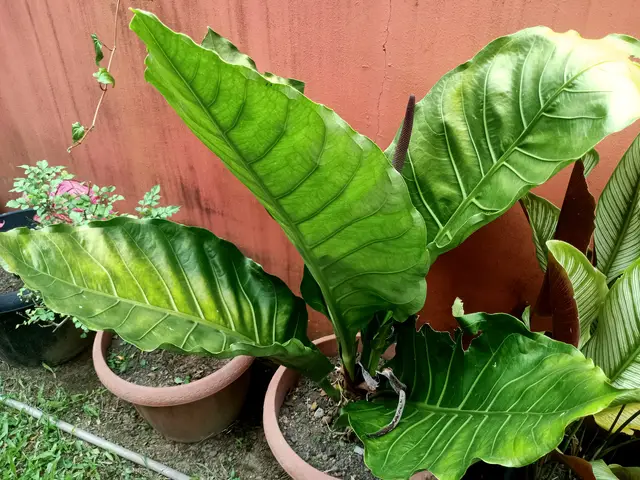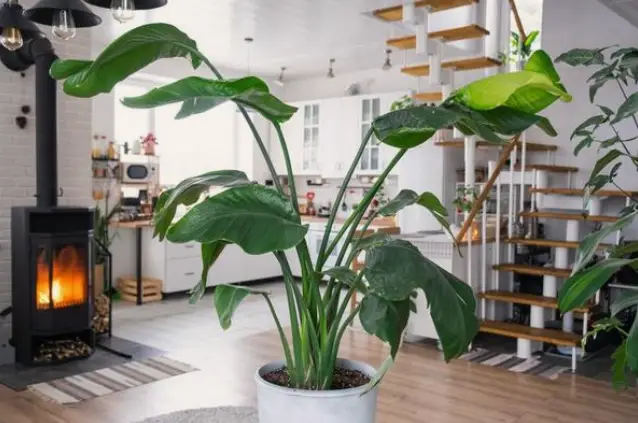Tropical environment, where the Gigantic Elephant Ear Plant is king of the flora.
If you have ever been mesmerized by the lavish beauty of this towering green giant, you are in good company.
We will explore the world of the Giant Elephant Ear Plant together, looking at its evolutionary history, distinctive traits, and the intricate artistry required to cultivate and maintain this magnificent foliage.
Whether you have the seasoned knowledge of a horticulturist or are a novice gardener, prepare yourself for a transformative journey that will transform your yard into a captivating tropical paradise.
Meet the Gigantic Elephant Ear Plant

From the enormous Alocasia to the enormous Colocasia, discover the diversity of these fascinating species.
Among the many species of Elephant Ear Plants, the Gigantic Elephant Ear is a botanical wonder.
Originating from lush tropical regions, this oversized spectacle commands attention with leaves that can stretch several feet in length.
The foliage of the Gigantic Elephant Ear is a masterpiece in itself, adorned with intricate patterns and a vibrant palette that imparts an exotic grace to any garden.
Choosing the Perfect Location

When it comes to soil, the Gigantic Elephant Ear exhibits a preference for well-draining, nutrient-rich substrates, which are necessary to support its vigorous growth.
Dig deeper into the subtleties of microclimates and soil compositions to customize your gardening approach to the unique needs of this botanical giant.
This majestic plant thrives in dappled to full shade, making it the quintessential choice for those seeking to infuse their garden with a tropical ambiance.
Planting and Propagation Tips
When launching the Gigantic Elephant Ear into its lush journey, timing becomes crucial.
Planting should take place in the warmer months, when the soil stays consistently above 50°F (10°C).
Learn the art of propagation, which is a rewarding aspect of growing this massive plant.
Methods like division and rhizome cuttings open doors to collection expansion, enabling you to share the majestic beauty of the Gigantic Elephant Ear with other enthusiasts.
Master the science of propagation by learning about the nuances of soil preparation.
Caring for Your Majestic Plant
Maintaining a healthy Gigantic Elephant Ear requires a delicate balance between fertilization and watering.
These plants prefer consistently moist soil, but they do not tolerate being overly wet. Check the moisture content of the soil on a regular basis and adjust your watering schedule accordingly.
In terms of nutrition, a well-balanced fertilizer applied sparingly during the growing season becomes the life force that keeps your Elephant Ear vibrant and alive.
Learn about cutting-edge methods like foliar feeding and organic fertilizers to customize your approach to your Gigantic Elephant Ear’s particular requirements.
Dealing with Pests and Diseases
While the Gigantic Elephant Ear stands as a robust sentinel, it is not impervious to the insidious advances of pests and diseases.
Vigilance is key, with common adversaries such as aphids and spider mites requiring your attention.
Implement preventive measures rooted in ecological harmony, such as neem oil and insecticidal soap, ensuring the protection of your plant without compromising the delicate balance of your garden’s ecosystem.
Designing with the Gigantic Elephant Ear Plant
Turn your backyard retreat into a tropical sanctuary by carefully arranging the Gigantic Elephant Ear into the lush tapestry.
These magnificent plants become outstanding focal points, and their striking foliage harmonizes well with a variety of garden designs.
Take a tour through the senses by experimenting with companion plants, like ferns and hostas, to create visually striking arrangements that highlight the regal splendor of the Gigantic Elephant Ear.
Let your imagination run wild as you investigate landscape design concepts, integrating this majestic plant into evocative and calming compositions.
Seasonal Care Guidelines
Prepare your Gigantic Elephant Ear for the rhythmic cadence of changing seasons. As winter’s chill encroaches, provide protective mulch around the base and, if need be, usher potted plants indoors.
In the embrace of summer’s warmth, ensure your plant receives the hydration it craves, for the elevated temperatures may intensify its moisture needs.
Adhering to these nuanced seasonal care guidelines ensures your Gigantic Elephant Ear remains a perennial beacon, radiating vitality and splendor throughout the tapestry of the year.
Conclusion
The Gigantic Elephant Ear will add a tropical touch of grandeur to any space, whether you are trying to create a dramatic focal point for your garden or an elegant centerpiece for your indoor retreat. Soak up the natural world’s inherent beauty and watch your green space become a captivating paradise. Happy gardening!
Here are some frequently asked questions (FAQs) about the Gigantic Elephant Ear Plant
Q1: What is the Gigantic Elephant Ear Plant?
A1: The Gigantic Elephant Ear Plant is a tropical foliage plant known for its oversized leaves, striking patterns, and vibrant colors. It belongs to the broader family of Elephant Ear Plants and is prized for its grandeur and exotic appearance.
Q2: How big do the leaves of the Gigantic Elephant Ear Plant grow?
A2: The leaves of the Gigantic Elephant Ear Plant can reach impressive sizes, stretching several feet in length. The sheer magnitude of its leaves contributes to its commanding presence in gardens and landscapes.
Q3: Where does the Gigantic Elephant Ear Plant originate from?
A3: The Gigantic Elephant Ear Plant is native to tropical regions, where it thrives in warm and humid climates. It has become a popular choice for gardens and landscapes worldwide, adding a touch of tropical elegance.
Q4: What are the ideal growing conditions for the Gigantic Elephant Ear Plant?
A4: The Gigantic Elephant Ear Plant thrives in partial to full shade and prefers well-draining, nutrient-rich soil. It is essential to maintain a balance of moisture without allowing the soil to become waterlogged.
Q5: When is the best time to plant the Gigantic Elephant Ear?
A5: The optimal time for planting the Gigantic Elephant Ear is during the warmer months when the soil temperature is consistently above 50°F (10°C). This ensures a favorable environment for root development and overall growth.
Q6: How do you propagate the Gigantic Elephant Ear Plant?
A6: The Gigantic Elephant Ear Plant can be propagated through methods such as division and rhizome cuttings. These techniques involve separating and replanting sections of the plant to encourage new growth.
Q7: What are the common pests and diseases that affect the Gigantic Elephant Ear?
A7: While the Gigantic Elephant Ear is generally robust, it can be susceptible to pests like aphids and spider mites. Implementing natural remedies such as neem oil and insecticidal soap can help manage these issues.
Q8: Can the Gigantic Elephant Ear be grown indoors?
A8: Yes, the Gigantic Elephant Ear can be grown indoors in containers. However, it’s crucial to provide it with the right conditions, including bright indirect light and well-draining potting mix. Indoor plants may benefit from occasional outdoor exposure for optimal growth.
Q9: How do I design my garden with the Gigantic Elephant Ear Plant?
A9: The Gigantic Elephant Ear makes an excellent focal point in gardens. Experiment with its placement to create visual interest. Pair it with companion plants like ferns and hostas to design harmonious and captivating landscapes.
Q10: How do I care for the Gigantic Elephant Ear during different seasons?
A10: During winter, provide protective mulch around the base and consider moving potted plants indoors. In summer, ensure the plant receives adequate water, as warmer temperatures may increase its moisture requirements.




